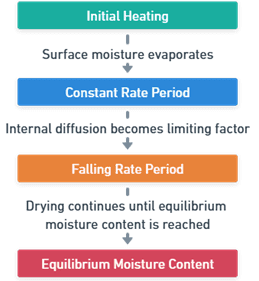Objectives of Drying
- Preservation: Removing moisture from materials to prevent spoilage and microbial growth.
- Weight Reduction: Reducing the weight for easier handling, storage, and transportation.
- Volume Reduction: Decreasing the volume for efficient storage and packaging.
- Consistency: Achieving a specific consistency or texture in products, particularly in food processing.
- Preparation for Further Processing: Preparing materials for additional processes like milling, mixing, or chemical reactions.
- Quality Improvement: Enhancing the stability and quality of the final product by controlling moisture content.
Applications
- Food Industry: Dehydrating fruits, vegetables, meat, and dairy products to increase shelf life.
- Pharmaceuticals: Drying drugs and medicinal powders to ensure stability and efficacy.
- Agriculture: Drying grains, seeds, and hay to prevent spoilage during storage.
- Textiles: Removing water from fabrics after washing or dyeing.
- Chemicals: Drying chemicals and intermediates to maintain purity and quality.
- Construction: Dry lumber, bricks, and other building materials.
- Paper Industry: Dry paper pulp to produce various types of paper products.
- Ceramics: Dry clay and ceramic products before firing.
Mechanism
1) Heat Transfer:
- Heat is supplied to the material to increase its temperature and provide the energy needed for evaporation.
- This can be achieved through various methods such as conduction, convection, or radiation.
2) Mass Transfer:
- Moisture inside the material moves to the surface and evaporates into the surrounding air.
- This involves the diffusion of water molecules within the material and the movement of water vapor away from the surface.
Steps in the Process
1) Initial Heating:
- The material is initially heated, and surface moisture begins to evaporate.
2) Constant Rate Period:
- The rate of drying remains constant as surface moisture continues to evaporate.
- This phase depends on the rate of heat transfer to the material.
3) Falling Rate Period:
- As surface moisture is depleted, internal moisture must migrate to the surface.
- Its rate decreases as internal diffusion becomes the limiting factor.
4) Equilibrium Moisture Content:
- It continues until the material reaches its equilibrium moisture content, where the moisture content is in balance with the surrounding environment.
Factors Affecting the Process:
- Temperature: Higher temperatures generally increase the dry rate but can also affect the quality of heat-sensitive materials.
- Humidity: Lower ambient humidity levels enhance the dry process by increasing the vapor pressure gradient.
- Airflow: Increased airflow over the material surface helps remove evaporated moisture, enhancing the drying rate.
- Material Properties: The initial moisture content, permeability, and thickness of the material significantly influence the drying process.
- Surface Area: Greater surface area of the material exposed to air can increase the drying rate.
- Drying Method: Different drying methods (e.g., air drying, vacuum drying, freeze drying) have varying efficiencies and suitability depending on the material and desired end product.
Understanding these principles helps in optimizing the dry process for specific applications, ensuring quality and efficiency in production.
Click Here to Watch the Best Pharma Videos


